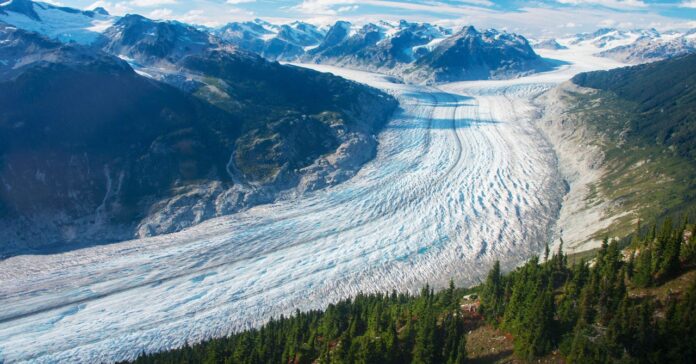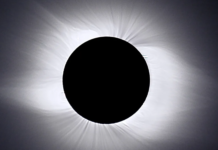If you haven’t hiked across a glacier yet, you might want to get booted up sometime soon. The world’s high-mountain glaciers are melting faster than scientists previously thought; since 2015, they have been losing nearly 300 billion tons of ice per year. If this rate of melting continues, many could disappear entirely by the middle of the century, according to a comprehensive new study out today.
Researchers in Canada, France, Switzerland, and Norway collected 20 years of satellite images taken from a special camera on a NASA satellite called Terra. The device, called ASTER, for Advanced Spaceborne Thermal Emission and Reflection Radiometer, took images of more than 210,000 glaciers around the world, photographing each with two separate lenses to create three-dimensional views of their surface features. The study excluded the massive ice sheets that cover Greenland and Antarctica, which are being studied by other teams of scientists.
The new analysis, published today in the journal Nature, found that between the years 2000 and 2004, glaciers lost 227 billion metric tons of ice per year. But between 2015 and 2019, this rate increased to 298 billion tons annually, a change the study’s authors attribute to warmer temperatures and increased precipitation. Taken together, that meltwater running down rivers and into oceans represents about one-fifth of the observed rise in sea levels over the past 20 years.
And the problem isn’t just sea level rise, although that’s a significant issue, threatening the welfare of residents in coastal nations like Indonesia, Bangladesh, Panama, the Netherlands, and some parts of the United States. In some inland regions, millions of people depend on snowmelt for clean water; in years when there isn’t much snow, glaciers offer a backup water source. That’s especially true in parts of the Andes, the Himalayas, and Alaska. “They provide cool, plentiful water for many systems throughout the planet,” says Brian Menounos, professor of Earth sciences at the University of Northern British Columbia and an author on the new study. “Once those glaciers are gone, you don’t have that buffering capability.”
Menounos says that previous studies of glacial melting took fewer measurements in both space and time, leading to some fuzziness about how much the glaciers were actually shrinking. By using detailed satellite imaging, he says, “We were able to show that with our estimates, we greatly reduced the uncertainty.” To crunch the numbers for all 211,000 glaciers, it took a supercomputer at the University of Northern British Columbia running almost full-time for a year.
The new analysis provides a grim warning about the future, says Jonathan Bamber, a professor of geographical sciences at the University of Bristol who was not involved in the study. “This is the most comprehensive, detailed, and thorough assessment of global glacier mass loss over the 21st century ever undertaken,” he wrote in an email to WIRED. “The level of detail in the results enables us to see changes on individual glaciers across the world for the first time.”
Bamber says the analysis shows that if the trend continues, some low-altitude mountain regions will lose their glaciers entirely by the year 2050. “While the results and work are impressive, the headline message is pretty gloomy,” Bamber continued. “Glaciers are on the way out, with profound impacts for water resources, natural hazards, sea level rise, tourism, and local livelihoods.”
The study’s authors agree with that assessment, and Menounos said that some areas, like the Cascades and Montana’s Glacier National Park, will likely be ice-free by mid-century. “See them while you can,” he urges.
Water from rapidly defrosting glaciers can trigger environmental disasters, as in February, when a melting Himalayan glacier collapsed in northern India, sending a wall of water down a narrow valley into two dams and killing 200 people. A 2018 report by the United Nations International Panel on Climate Change found that a warming climate is responsible for making high mountains more likely to see these kinds of killer floods and landslides. “Glacier retreat and permafrost thaw are projected to decrease the stability of mountain slopes and increase the number and area of glacier lakes,” the report’s authors concluded. “Resulting landslides and floods, and cascading events, will also emerge where there is no record of previous events.”
Today’s study by the Canadian and European researchers also found that melting glaciers in Alaska, Western Canada, and the US are responsible for nearly half of the accelerated glacier mass loss worldwide. “The Alaskan Panhandle has been a worrisome area,” Menounos points out. “In the last decade, that has really undergone tremendous change.” In that state, the melting ice has also led to an increase in the magnitude of earthquakes, as the land underneath a glacier rises, releasing pressure and affecting forces on nearby fault zones, according to a study by researchers at the University of Alaska, Fairbanks, published in March in the Journal of Geophysical Research.
While the news is bad, experts have been impressed with the amount of data the team was able to collect from satellite images spanning 20 years. “I thought this was fantastic, actually,” says Tom Neumann, chief of the cryospheric sciences laboratory at NASA’s Goddard Space Flight Center. “It’s a real testament to the power of a time series. A lot of times, these missions have a lifetime measured in five or seven years. The fact that they are still collecting fantastic data is just phenomenal. It really enabled the team to do something that’s never been done before.”
Neumann is the project scientist for NASA’s ICESat2 mission, a satellite launched in 2018 that is bouncing lasers off the Earth’s polar regions to accurately measure the loss of glaciers, as well as polar ice sheets, to track the melt’s effects on global sea level rise. “I hope we get to 20 years,” Neumann said, “so that one day so we can write a paper like this.”
- 📩 The latest on tech, science, and more: Get our newsletters!
- The cold war over McDonald’s hacked ice cream machines
- What octopus dreams tell us about the evolution of sleep
- The lazy gamer’s guide to cable management
- How to log in to your devices without passwords
- Help! Am I oversharing with my colleagues?
- 👁️ Explore AI like never before with our new database
- 🎮 WIRED Games: Get the latest tips, reviews, and more
- 🏃🏽♀️ Want the best tools to get healthy? Check out our Gear team’s picks for the best fitness trackers, running gear (including shoes and socks), and best headphones








